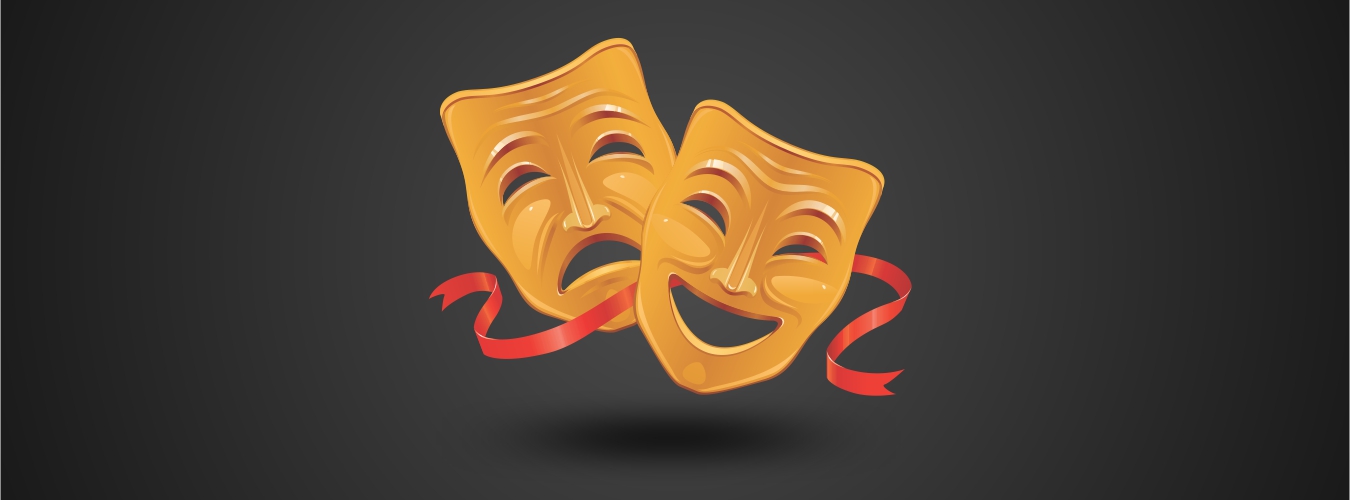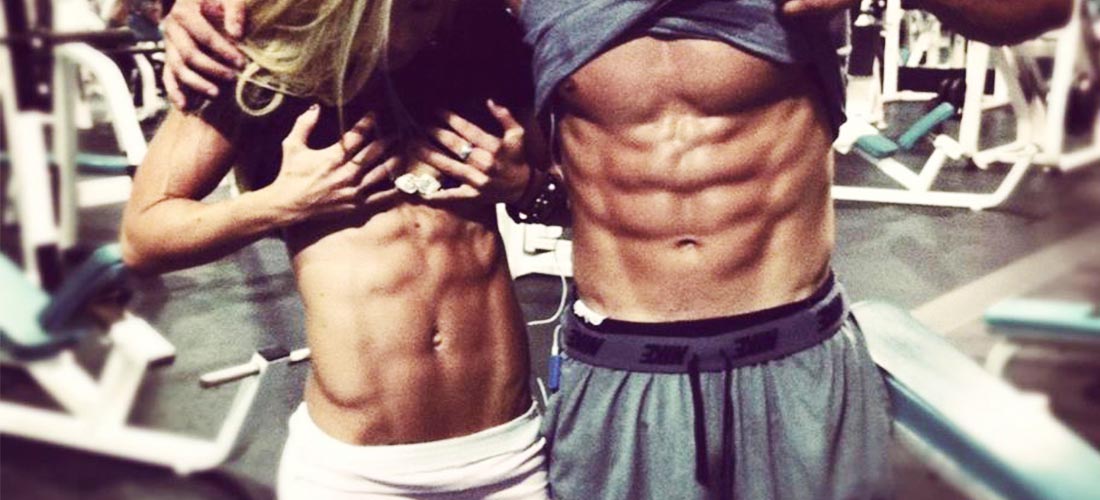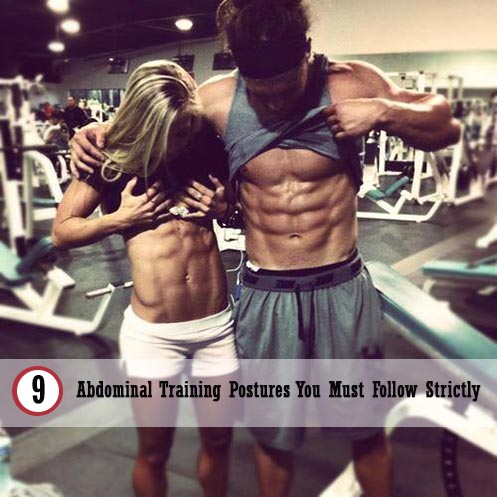Building six pack abs is not a Tom Dick and Harry’s task. You need to prepare yourself before pulling off reps to build your muscles. Last time we told about whether you are fit enough for abdominal training or not.Want to have the best muscle among your hot bod friends? Follow these 9 abdominal training exercises to get a step closer to your dream!
Kneeling Hip Flexor Stretch
target Area: Hips, thighs
Starting Position: Begin by kneeling on your right leg (half kneeling) with your left leg bent in front of you. Lightly tighten (tense) your abdominal muscles, breathing normally.
Points to Note: This exercise stretches the hip flexor muscles as they pass in front of the hip joint.However it will also press the ball of the hip socket (head of femur) forwards in its socket. In some cases this may cause pain. If so it may indicate that the hip is anterior-ly displaced (help forwards by tight tissue) and requires specialist treatment from a physiotherapist.
Training Tip: Its is essential that the lower spine does not hollow as you press your hips forwards. When this happens the movement is occurring at the lumbar spine rather than the hip.
Double Knee to Chest Stretch
Starting Position: Lie flat on the floor with your knees bent,and feet flat. This will have the effect of rounding the lower spine in the opposite direction to the hollow back.
Action: Grip your legs behind your knees and pull the knees in towards the chest. At the point where there is no further hip movement ( the legs stop moving ), pull in a little further so that our tailbone lift from the mat.
Points to Note: some people have quite stiff hips[1], so the spine will begin to move when the knees are quite far from the chest. For others, the knees may have to be pulled right up onto the rib-cage before the spine begins to move. The aim of the exercise is to tilt the pelvis and flex (round) the lower lumbar spine, posterior-ly. The pulling action on the legs is therefore in and up.
Training Tip: Make sure that the movement is slow and controlled. Never force the spine to move if it is stiff[2], but encourage it gently.
Chest Stretch in Room Corner
Target Area: Pectoral muscles
Starting Position: Begin standing in the corner of a room with your upper arms horizontal and forearms vertical. Place one forearm on each wall.
Action: slowly lean forwards. Press your chest into the comer of the room.
Points to Note: The exercise places stress on the shoulder joint itself. Normally this is not a problem, but if you have ever dislocated your shoulder, do not use this action unless you are supervised by a physiotherapist.
Training Tip: If you find this stretch very hard, take up a lunge position (one foot in front of the other) so that less of your body-weight is taken on your shoulders.
Chin Tuck and Hold
Starting Position: Begin lying on the floor. If your head tilts backwards, place a folded towel beneath it.
Action: Tuck your chin in as though trying to place it into the top of your breastbone (sternum). Hold the inward position for 5-10 seconds, breathing normally.
Points to Note: There is very little movement in the action, but you should feel a slight stretch at the top of your neck (sub-occipital region).
Training Tip: If your neck is very stiff, you can place a little pressure on your chin with your fingers. Try this for 2-3 repetitions before you hold for 5-10 seconds.
Shoulder Brace
Starting Position: Lie on the floor with your arms by your sides and a that cushion or folded towel beneath Your chest.
Action: Gently tighten your abdominal muscles and draw your shoulder blades together slightly. Lift first your arms, and then your head and chest from the floor. Hold the lifted position for 2-3 seconds and then lower slowly.
Points to Note: The tightening action of the abdominal muscles and shoulder blades stabilizes both your lower & upper spine[3] during this exercise. ‘You only need to lift high enough for your chest to clear the ground. Do not over arch your back.
Training Tip: Imagine the top of your head is being pulled to the far wall as you lift. This will help you lengthen your spine rather than over arching it.
Thoracic spine stretch over roll
Starting position: Begin lying on the floor with a rolled towel or foam roller placed cross-ways beneath your upper back. Lightly tighten your abdominal muscles by drawing them inwards.
Action: Breathe normal and, with each breath out (expiration), try to relax over the roll to encourage your spine to be pressed flat (extension). Lie in this position for 2-3 minutes.
Points to note: There may be very little movement available,especially if your spine is very tight.Initially this position may be quite uncomfortable, but this should subside in about 30 seconds as your muscles relax. If you feel pain which increases,stop the exercise and consult a physiotherapist.
Training tip: If you find you head tips back, place a folded towel beneath your head. If you find your back hollows excessively,bend your knees.
Standing spine lengthening
Starting position: This exercise comes from yoga, where it is called the mountain pose aasana. Begin standing, with your feet together, and hands by your sides.
Action: Work from the floor upwards in a sequence. Lift your inner ankles slightly, correcting any tendency to flatten your feet. Tighten your thigh muscles (quadriceps) and draw your legs together (hip adductors). Pull your tummy in slightly and draw your tailbone downwards, correcting any tendency to over-arch your spine. Draw your shoulder blades together slightly and downwards (adduction and depression) and finally tuck your chin in.
Points to note: Each of these movements is very slight, tightening the posture muscles in turn. Take care not to tense too much or hold your breath.
Training tip: Reach the crown of your head to the ceiling and the tips of your fingers to the floor.
Low back extension stretch
Starting position: Begin lying on the floor with your arms bent and hands by your sides- the press-up position.
Action: press with your hands and lift your chest from the floor keeping your hips down. Push for 5 seconds, and then hold the upper position for 5 seconds and then lower.
Points to note: If your spine is very tight,you may not be able to lift very high. By repeating the action,however, you should find that your lower back becomes more flexible.
Training tip: If you have very little movement, you will find it easier on your arms to place your hands further forwards on the mat.
The hip hinge
Starting position: Begin by holding with your feet hip-width apart. Hold a stick along the length of your spine so that you have three points of contact- tailbone, upper spine and head resting on the stick. Gently tighten your abdominal muscles.
Action: Bend your knees and hips,and angle your spine forwards to 45 degrees, keeping your three points of contact with the stick at all times.
Points to note: If you allow your back to bend,you will notice your head moving off the stick (upper spine rounding), or your tail moving off the stick (lower spine rounding).
Training tip: rather than bending forwards, think about pointing your tail to the wall. Encourage a tipping( hip flexion) rather than bending (spine flexion) action of the spine.
Enough of knowledge work done with this article. Now t’s time to get rolling with these exercise! To know more read about how to do Cobra Abdominal stretch!
References: [1] Megan M. Groh and Joseph Herrera. A comprehensive review of hip labral tears. Curr Rev Musculoskelet Med. 2009 June; 2(2): 105–117. Published online 2009 April 7. doi: 10.1007/s12178-009-9052-9. [2] Steven J Atlas, MD, MPH1 and Richard A Deyo. Evaluating and Managing Acute Low Back Pain in the Primary Care Setting. J Gen Intern Med. 2001 February; 16(2): 120–131. doi: 10.1111/j.1525-1497.2001.91141.x [3] Jason Brumitt and R. Barry Dale. Integrating Shoulder and Core Exercises When Rehabilitating Athletes Performing Overhead Activities. N Am J Sports Phys Ther. 2009 August; 4(3): 132–138.







Comments are off this post!